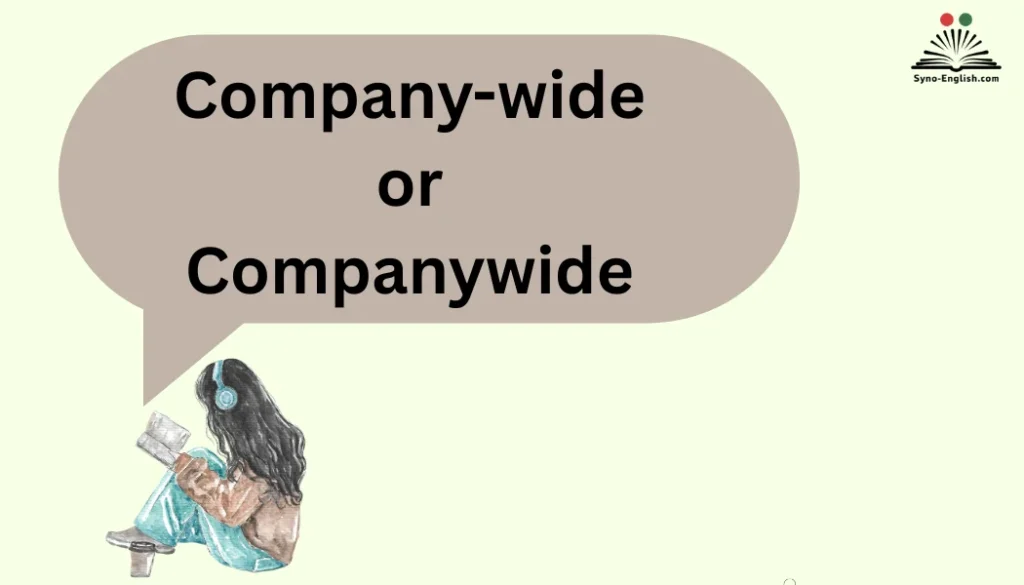The English language constantly challenges writers with unique curveballs of hyphenation and tone. Choosing between company-wide or companywide isn’t just a grammar issue—it’s a matter of credibility, readability, and professional communication, influencing how your business message is perceived by different audiences across industries.
I remember writing my first report and struggling with style preferences that shaped how formal or approachable my tone felt.Over time, I noticed corporate documents, emails, and press releases display multiple variations of the same expression.
Some rely on specific guides or dictionaries to determine which form fits their writing, while others base their choice on branding or consistency. This debate isn’t about right or wrong—it’s about clarity. Rules help, but expertise means knowing how to adjust them according to context and platforms without losing the professional style your company is known for.
to Hyphen Usage in American English
Hyphens aren’t just punctuation marks—they’re structural glue in English. They connect words to clarify meaning and avoid ambiguity. For example:
- “fast moving company” could mean a company that moves quickly or a company that relocates.
- “fast-moving company” removes the doubt.
In American English, hyphens often appear in compound modifiers (two or more words that describe a noun). They ensure precision. But as language evolves, many compounds start hyphenated and later close into one word (like email, which was once e-mail).
This evolutionary shift is why both company-wide and companywide coexist today.
Company-wide vs. Companywide: The Two Accepted Forms
The heart of the debate lies in whether the hyphen is necessary.
- Company-wide: The traditional, hyphenated form, widely accepted in formal and editorial writing.
- Companywide: The newer, closed compound that’s gaining popularity, especially in branding and corporate messaging.
Both forms appear in respected dictionaries. For example:
| Dictionary | Listed Form | Notes |
| Merriam-Webster | companywide | Defines without hyphen, but lists “company-wide” as a variant |
| Oxford English | company-wide | Hyphenated as the main entry |
| American Heritage | companywide | Acknowledges non-hyphenated as standard |
| Collins English | company-wide | Considers hyphen essential in compound adjective |
Fact: Google’s Ngram Viewer shows that company-wide dominated in print throughout the 20th century, but companywide has surged in digital and corporate contexts since the early 2000s.
Professional Perception of Hyphenated vs. Non-Hyphenated Forms
How does each version read to your audience?
- Hyphenated (company-wide):
- Feels more formal, polished, and editorial.
- Fits well in press releases, legal documents, and journalistic contexts.
- Signals adherence to style guides like AP or Chicago.
- Closed compound (companywide):
- Feels modern, streamlined, and brand-friendly.
- Common in digital marketing, websites, and internal communications.
- Matches corporate preference for brevity and visual simplicity.
Think of it this way: hyphens feel traditional, closed compounds feel contemporary. Both communicate clearly, but tone shifts depending on choice.
The Purpose of Hyphens in Compound Adjectives
Hyphens exist to prevent misreading. In English, compound adjectives come before nouns and often need a hyphen to bind them.
Examples:
- A high-quality product vs. a high quality product.
- A long-term strategy vs. a long term strategy.
Without the hyphen, readers may stumble or misinterpret.
Applied here:
- A company-wide initiative clearly means an initiative that affects the entire company.
- Writing company wide initiative as two words creates confusion and breaks grammar rules.
When to Use Company-wide and Companywide Correctly
Here’s the practical takeaway: both forms are correct, but usage depends on context.
- Use company-wide when:
- Following AP Style or editorial rules.
- Writing in formal business documents, journalism, or academic texts.
- You want your tone to lean traditional and authoritative.
- Use companywide when:
- Writing for internal communications, casual business writing, or corporate branding.
- Creating website copy or marketing material where brevity matters.
- Following dictionary usage that favors closed compounds.
✅ Avoid company wide as two separate words. It’s grammatically wrong and universally rejected.
Applying the Rule Before Nouns
Hyphen use often depends on placement:
- Before a noun (compound adjective):
- Correct: The company-wide survey gathered valuable insights.
- Correct: The companywide survey gathered valuable insights.
- Incorrect: The company wide survey gathered valuable insights.
- After a linking verb:
- Hyphen unnecessary.
- Example: The changes are companywide.
Notice how the form changes depending on grammar position.
AP Style Guidance on Compound Adjectives
The Associated Press (AP) Stylebook, a cornerstone for journalists and corporate communicators, has specific rules:
- Use hyphens for compound modifiers before a noun when not clear without one.
- Do not hyphenate after the noun.
So AP would recommend:
- Company-wide reorganization (before noun).
- The policy is companywide (after noun).
Other guides:
- Chicago Manual of Style (CMOS): Accepts both companywide and company-wide, leaning toward closed compounds over time.
- APA Style: Prefers clarity and often recommends hyphenation when ambiguity exists.
Common Mistakes: The Case Against “Company wide”
The biggest pitfall is writing company wide as two words. Here’s why it fails:
- It doesn’t function as a proper compound adjective.
- It creates unnecessary ambiguity.
- No dictionary or style guide supports it.
Incorrect examples:
- The company wide event was successful.
- New company wide rules apply next month.
Correct these as:
- The company-wide event was successful.
- New companywide rules apply next month.
Real-World Examples
Let’s look at how major organizations handle the choice:
- The New York Times: Favors company-wide.
- Forbes & Fortune: Frequently use companywide in business reporting.
- Microsoft & Google: Their press releases prefer companywide.
- Legal and HR documents: Almost always use company-wide for formality.
Case Study: Google’s 2020 Work-from-Home Announcement
When Google announced its extended remote work policy, official press releases described it as a companywide decision. The choice aligned with modern, digital-first business communication.
Case Study: United Airlines Annual Report
In contrast, United Airlines’ annual financial report used company-wide consistently, signaling formality and adherence to traditional editorial standards.
This shows that context drives choice more than correctness.
Usage Data: Which Form Wins Online?
Search engine data adds another layer of insight.
| Term | Google Search Results (approx.) | Notes |
| Company-wide | 7.2 million | Still strong in journalism and formal writing |
| Companywide | 4.9 million | Gaining ground in corporate and digital contexts |
| Company wide | 120,000 | Almost always flagged as an error |
SEO Note: If writing for a business blog, use both variations naturally. This ensures coverage for search intent since users type both forms.
Conclusion
In today’s fast-paced business world, choosing between company-wide and companywide might seem like a minor detail, but it represents much more than spelling. It reflects the precision and tone of your professional communication. When you understand the subtle differences in style, you enhance your credibility and strengthen your business writing. Whether you follow traditional guides or modern simplicity, being consistent across documents, emails, and press releases builds trust and clarity within your organization.
Ultimately, the right choice depends on your audience, brand, and the context of your communication. Writers who learn to balance rules with real-world usage show adaptability and attention to detail—traits essential for modern professionals. As language evolves, embracing flexibility while maintaining consistency is key. So, whether you choose company-wide or companywide, the goal is not perfection but connection. Your writing should convey confidence, professionalism, and a clear understanding of how small linguistic choices shape larger organizational impressions.
FAQs
What does company-wide or companywide mean?
Both forms describe something affecting an entire company, like policies, initiatives, or announcements.
Which form is grammatically correct?
Both are accepted, though “company-wide” is more traditional, and “companywide” is gaining popularity.
Should I use the hyphenated form in formal writing?
Yes, many style guides still recommend “company-wide” for formal documents.
Does spelling affect professionalism?
Absolutely. Consistent spelling maintains a polished corporate image.
Which version do most companies prefer?
It depends on internal style preferences or brand guidelines.
Can both be used interchangeably?
Yes, but maintain consistency throughout your text.
What’s the rule in dictionaries?
Modern dictionaries recognize both forms, labeling them as correct variants.
Why do writers get confused?
Because both forms look natural, leading to uncertainty about usage.
Is companywide becoming more common?
Yes, it’s gaining ground, especially in digital and informal writing.
How can I decide which to use?
Follow your company’s preferred style guide or maintain consistency across all professional materials.

Emma Brooke is a passionate English educator, writer, and language enthusiast with over a decade of experience helping learners master the nuances of the English language. At SynoEnglish, she blends practical grammar advice with real-world communication tips to make English easier, clearer, and more enjoyable for readers of all levels.



